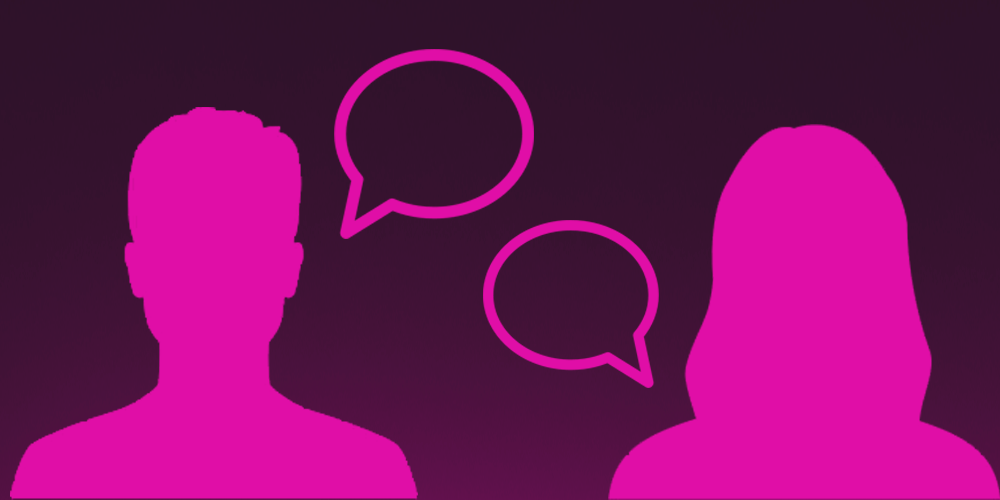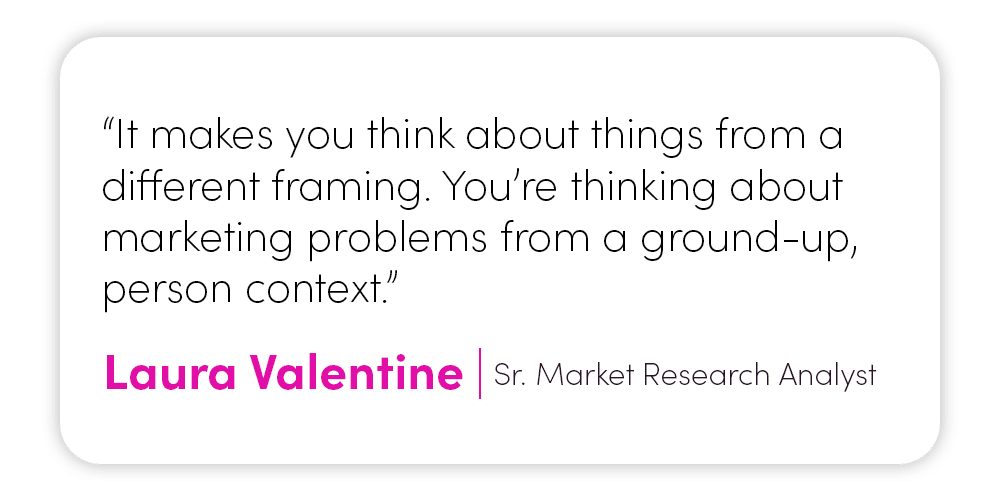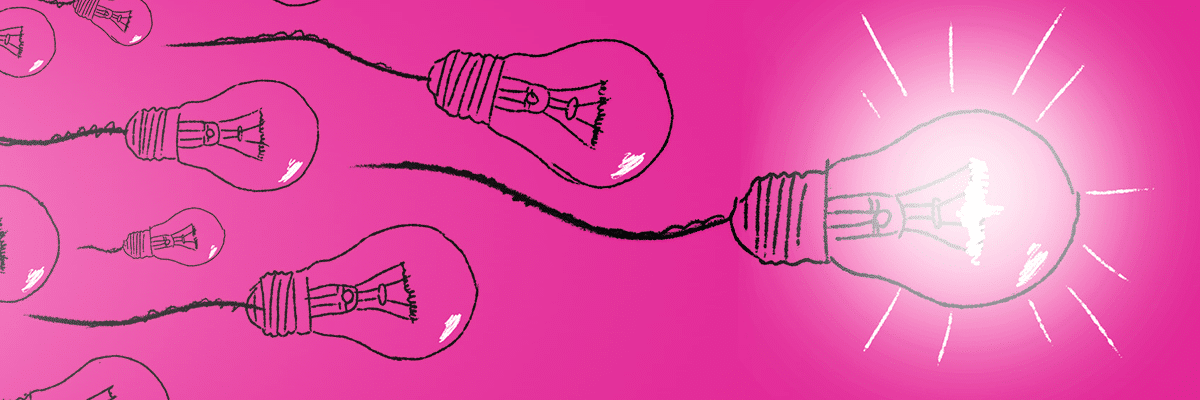At (human)x, we believe research is the foundation of any good work. If you want to break through the digital noise, you have to start by uncovering those unique human insights that will allow you to develop the meaningful experiences and messaging that make your brand truly matter more.
We believe so much in the power of rigorous research that, years ago, we created our own in-house, PhD-led research team. Is that typical for a mid-size, independent ad agency? No way. Has it proved to be highly effective? That’s a resounding yes. (Just check out some of our recent case studies.)
Our passion for understanding how people think and make decisions is also what drove us to create humanView, our own proprietary predictive modeling product. (For more about that, check out our previous blog interview with Dr. Timothy Sauer, (human)x Director of Research), or head over to our website for specifics.) Outside of humanView, our team has been incorporating AI technologies into their research process, using machine learning tools to scrape, code and analyze massive amounts of data.
So with all these new AI technologies, do we still need humans to do our marketing research? And what does robust research entail, anyway?
“That’s a great question!” the (human)x research team replied, eager to apply their tools to a new challenge. “Clients come to us with a problem and we re-position it as our research question,” said Laura Valentine, (human)x Senior Market Research Analyst. “What is the fundamental thing we’re trying to answer? We have a lot of different tools and resources to do that. The cool thing is, you can always bring back your marketing activities back to research to keep finding out more things and refining what you know.”

Very cool, indeed. This month, we sat down with Laura and her colleague Kit Benken, Senior Marketing Research Analyst at (human)x, to peek behind the curtain and learn how our data scientists are using rigorous academic tools along with predictive modeling software, large language models and their own human intelligence to uncover new insights about human behavior, actions and activities.
What are some interesting projects you’ve been working on recently?
Kit: I just wrapped a project with a national home improvement product brand, and without the research, the logo redesign would have gone a completely different way. But what is important to inform logo development is what the stakeholders think and, even more importantly, what the audience thinks and how you can communicate to them. I did internal stakeholder interviews and Laura did competitive analysis focused on brand identity placement and brand messaging, which, interestingly, were not super aligned. There was kind of a different story for each of those.
Then we did focus groups, including heads of household, professionals, DIYers, and artists, getting to know what they thought of the brand and what spoke to them regarding branding. One of the key insights to come out of that research was that professionals will not use this brand’s products in a professional capacity. Their reasoning was, if I go into a person’s house, and I bring this brand, that’s going to undermine my credibility, because anyone can go to Walmart and buy it off the shelf. In their eyes, it was way more about optics than about performance.
That insight informed how our creative team developed the logo. This brand had been straddling the pro-sumer and consumer position, but based on this research, decided to focus on the consumer.
That’s a fascinating insight. You mentioned focus groups, stakeholder interviews and competitive analysis. What are some other tools you use in marketing research?
Laura: That’s such a good question and it’s a really long answer because ideally market research should act like a wheel. We do our initial research when we are introduced to a client, we do our stakeholder process, we do our initial competitive analysis, we do audience research, we do creative testing, and then we have findings and we have ideas and we have strategic directions we can take.
Then, working with the client, we figure out what can happen and we move forward with that campaign or that product idea or whatever the marketing activation is. But there are always opportunities to keep refining. So, maybe we settled on a logo but now we want to test packaging. We keep turning the research, keep refining.
It’s a hot topic today: How is AI changing the way you conduct research?
Laura: We’re starting to develop some tools that will speed up the process of certain qualitative coding processes. It still requires our touch as researchers to develop that and understand what the output is, but it’s a huge time saver that will allow us to collect more information on a greater scale. For example, we’ve been developing an AI tool that can scrape large data sets on the internet, whether it’s a set of reviews, a public forum, whatever. We can start to code things for sentiment and pull out certain themes.
So that’s something that would be really useful, for example, if you are trying to figure out the differentiators of your product. You can scrape 20,000 or 30,000 reviews and start to identify that people like the texture or the smell, whatever. That’s incredibly useful for campaign and product development.
Kit: It takes a lot of the assumption work out of qualitative analysis, because rather than saying, I hopped on Reddit and here’s what I think most people say. It allows you to know, actually, here’s what the average of 25,000 people are saying. You can quickly get an overview of consumer sentiment so that you can spend your time creating insights, rather than collecting data.
Laura: I’ve been using this platform called MaxQDA. QDA is qualitative data analysis. It has its own built in AI capability that you can train to understand how you’re coding or
labeling certain types of information. That’s highly useful from a time and budget perspective. Rather than me taking five business days to annotate a transcript, I can train the model and then AI can do it for me. That leaves more time for us to start building strategies. So, it’s better for clients, better for us.
What are some of the limitations of AI software that you’ve encountered?
Laura: From an anthropological perspective, if you’re talking about people from different backgrounds and different cultures who have different ways of describing the world, especially if we’re talking about people who are not the default, cis white male model, then you have to teach the AI how to understand the human language and the human affects and slang that it’s interpreting. If it doesn’t know certain words, especially if you’re thinking about, say, young person slang, you have to teach the machine how to interpret what that is. Otherwise, you can’t know.
Kit: Even if you could teach AI to understand different cultural nuances, you can’t program human empathy. There are different nuances that you just intuitively get because you’re a human. For example, with the professionals in the logo research I mentioned, their reasoning for not wanting to use this brand on the job was that it was available on Walmart shelves. Well, so are the competitive brands. But they responded a lot more positively to those brands and said that they would use them on the job.
But then, if you ask them, why do you think this about our brand and not about those others? At first, they said, Oh, I don’t know, just a feeling. And so you have to use your human brain to think, Okay, they also said stuff about the logo being cutesy, and about being familiar with the product growing up and feeling a level of nostalgia for it.
Eventually, their perceptions came down to cultural stigma. But AI wouldn’t have really picked up on that, because it would have said, Does not compute, they’re all available at Walmart. So, you have to bring a level of human empathy and intuition to your research that I just don’t think you can program.

Laura: The other element of it is that what AI can do right now is summarize, but it can’t interpret. It can’t think critically. So, you still need that human touch.
I think most people typically perceive research as being neutral and objective. What are some other ways that empathy might play a role?
Laura: Besides having a well written protocol, or whatever you’re using for data collection, empathy is the greatest thing that you can do in research. For example, we’ll be doing a focus group and clients will be shooting us follow up questions. Sometimes you might choose to ask that follow up question, sometimes you might not. That’s because the information that you can collect is directly connected to the rapport that you’re able to build with the people in your focus group.
You start to get an instinct as you are getting to know these folks, who’s going to be open about what and who can you probe. They’re not Google, right? We can’t just input a question and have them spit out the answer. You have to nurture that relationship.
(human)x is a LGBTQ-owned business and has a robust ID&E roadmap. Tell me about some of the ways diversity plays into research.
Kit: I am trans. And I would say representing a societally marginalized category of people can be really helpful for reaching similarly marginalized groups.
I was afraid coming out would make reaching some clients a lot more difficult. I did a lot of work interviewing blue collar professionals. And I had a lot of preconceived stuff in my head, like, they’re going call me a slur and threaten me. I didn’t think that, but I was just preparing for the worst. It ended up being fine.
On the flip side, one of the first clients I worked on independently was the Art Academy of Cincinnati. I had to do a lot of focus groups with students. I thought, I’m going to introduce myself with pronouns and be a little bit more open about my own experience. And I do feel like it developed a lot more rapport with the students. It got them to feel more comfortable speaking.
Laura: I will say that Kit and I are white. And coming in as white people doing research, you have to remove a lot of ego. It’s important to come from a de-centered position and know that there’s a lot of things I simply will never understand because I grew up in the U.S. as a white person.
But the other thing that Kit and I both understand, coming from an anthropological and not a marketing background, is that when you get into the room with the person that you’re interviewing or doing a focus group with, they become the most important person in the room who deserves all of your attention and respect.
Are there other ways that having an education in anthropology informs the way you approach marketing research?
Laura: I received my bachelor’s and master’s degrees in anthropology. And I would say that a lot of the benefit of that is being able to put on the social scientist hat when going into research. It makes you think about things from a different framing. You’re thinking about marketing problems from a ground-up, person context.
The other benefit is that, in doing my thesis, I had to create a research project and manage it on my own from end to end. That was everything from the proposal to the data collection, to developing methods, to reaching out to different people and organizations to get my project to work, to hunting down people to participate. I can anticipate a lot more of what can go right and what can go wrong within a project.

Kit: I have my undergraduate degree in anthropology and worked in nonprofits and museums after graduation, which prepared me for working with a lot of different members of the public. One of the key things that I took from anthropology was in the context of ethnography. You have to ingratiate yourself within a community of people, but you also have to recognize your own biases and go from there. That anthropology gives you the ability to chameleonize yourself is really important to what I do now in marketing research. I would not speak to a group of contractors the same way that I would speak to a group of Gen Z art school students.
I also spent a year doing research in Tanzania and Rwanda. There was a lot of a cultural shock that I just had to quickly get over and get on with my research. That was really helpful for my work today, when I might have five focus groups with five entirely different conversations and I just have to be ready to roll with the punches.
To learn more about a research team that knows how to roll with the punches, check out the full breadth of our capabilities on our human insights page.

